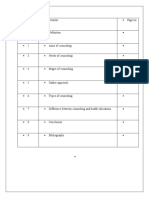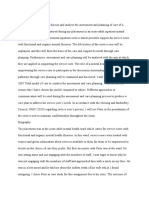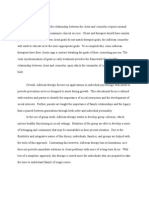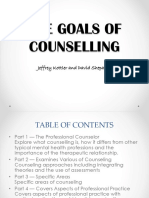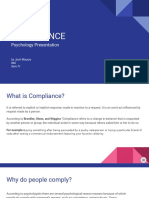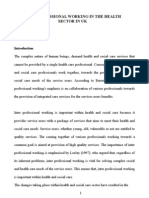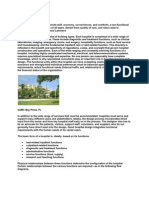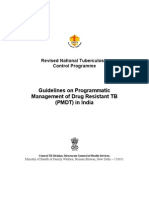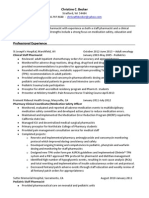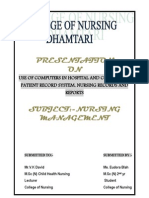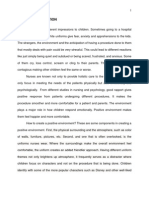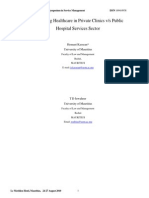Patient Counselling
Patient Counselling
Uploaded by
chivconCopyright:
Available Formats
Patient Counselling
Patient Counselling
Uploaded by
chivconOriginal Description:
Copyright
Available Formats
Share this document
Did you find this document useful?
Is this content inappropriate?
Copyright:
Available Formats
Patient Counselling
Patient Counselling
Uploaded by
chivconCopyright:
Available Formats
Introduction
The author is a staff nurse in a surgical ward which caters for elective and emergency admission patients with colorectal problems. The author is responsible for planning, implementation and evaluation of patient care. Other extended roles involves helping patients with their social problems by enlisting the services of other healthcare professionals and by spending time talking to patients.
The Patient
Mr Bambo was admitted for colostomy formation due to rectal cancer. The author cared for him pre and post operatively and knew the patient very well. The patient was a football fan and used to talk about football with the author who is also a keen football fan.
A few days after surgery, the author observed that, the patient's mood was very low, and appeared to be going through some difficulties. Although most colorectal surgical patients feel depressed post operatively because of the stomas that they have to cope with, the patient was so distressed that his diet intake was poor, was not keen on having visitors, did not not communicate much with his wife and was asleep most of the time. Using his nursing experience and basic counselling knowledge, the author 1 was of the opinion that, the patient would benefit from counselling. Given the
relationship that the author had developed with the patient, the chances of success was deemed high. Though the author had only basic counselling skills, it was the author's view that as a nurse he had an extended role to play in helping the patient. Freshwater (2003) said that, nurses whilst not skilled counsellors are expected to help their patients to deal with difficult situations.
What is Counselling
There are various definitions of counselling. However, despite the divergent views of what counselling involves, there is consensus on the fact that, counselling aims to provide clients with time and space to explore their problems, understand them, come to terms with them and find appropriate solutions (Sutton and Stewart:2008). The British Association for Counselling and Pschotherapy (2010) defined counselling as an interaction between two people in which one is offering help aimed at exploring and clarifying problems. Mcleod (2009) said that, counselling should take place in confidential settings, the idea being to help the client explore a difficulty and distressing situation.
Various approaches are used in counselling. The author utilised the patient centred approach which was developed by Carl Rogers. It is an approach that relies on a relationship between two people who are both committed to move towards finding 2 solutions to given problems (Mearns and Thorne:2007). For this to be helpful to the
client, the counsellor should create a relationship and an environment that support the exploration of the problem and the various appropriate solutions. Genuineness, respect, confidentiality, empathic understanding and a mutual relationship are vital for the success of counselling (Sutton and Steward:2008). Although the author was not a skilled counsellor, he endeavoured to carry out the counselling sessions with the vital ingredients of counselling in mind.
The author's strength was also drawn from the fact that, he has good nursing experience, is a good communicator and has been involved in basic informal counselling sessions as part of his everyday duties. Burnard (1995) said that, by the nature of their duties, nurses are involved in counselling patient's everyday. The Nurse's and Midwifery Council (NMC: 2008) makes it very clear that nurses have a duty of care towards their patients. This means that, whilst not professional counsellors, nurses have a role to play in helping their patients.
Patient's Needs Mr Bambo had a life changing surgical procedure that involved stoma formation due to rectal cancer. Rectal cancer is the major and frequent reason for permanent colostomy (Mullen and McGuinn:1992). The surgical procedure involves the creation of a new opening called a stoma in the abdomen wall and it is a life changing experience (Rayson:2003). The patient was worried about the quality of his life 3 because the surgical procedure was not reversible.
Despite the stoma care education he was getting from stoma specialist nurses and the routine care from the ward staff, the patient was not coping at all. Physio-therapists, occupational therapists and dieticians were all involved in his care with the aim of helping him to recover well from the surgery and to cope with his situation. All the help given was meant to build his confidence and empower him to take control of his life. According to White and Beart (2002) there is research evidence indicating that, positive adjustments post operatively is likely to take place when the patient feels confident and in control. However, despite all the help from various health care professionals the patient remained distressed about the quality of his life and how he was going to spend the rest of his life with the stoma. Consequently, he was not keen on having visitors especially his work mates and he was displaying signs of psychological problems. Larson (2005) observed that, most people who have undergone life changing surgery like stoma formation have serious worries and concerns which develop into serious psychological problems that require
intervention. The patient's needs required some intervention and counselling was the only appropriate form of intervention that could help him.
The Problem Although the surgical procedure saved his life, his main worry was his life after discharge. Whilst stoma formation procedures are performed because there is no 4 alternative, the challenge for the patient was coping with the life changing surgery
(White and Beart:2002). Such post operative challenges are prevalent among patient's with stoma (Mullen and McGuin:1992). Having a stoma is challenging because one will have to learn how to deal with practical aspects of stoma care (Rayson:2003). The patient was getting the care he needed and was being helped to adjust and cope with his new situation but he was not showing signs of coping, he was actually getting depressed each day. According to Larson (2005) some patients can move easily from decline to acceptance and accept their new situations but some will find it difficult to do so. The patient situation was better helped by counselling which the author deemed to be the most appropriate intervention. Counselling helps the client to discover new ways of perceiving their problems and help them to empower themselves (Culley:2004). Whilst acknowledging that he was not a skilled counsellor, the author was of the view that his basic counselling skills would help the patient to explore his problems, available solutions and find the most appropriate solutions. The author was aware of his limitations in counselling and how to handle this rather difficult endeavour. According to Burnard (1995) nurses should be aware of the limitations of their counselling skills and the risks associated with exceeding those limits.
Intended Outcomes The patient's situation was not only a concern to the author, other health care professionals but to his family as well. The author's aim was to help the patient to 5 deal with the situation he was facing. Counselling was the only appropriate
intervention that would help the patient explore his problems, come to terms with them, explore various solutions and decide on the most appropriate one. Mcleod (2009) said that, counselling offers an opportunity to explore and better comprehend bottled up feelings such as stress, grief, anxiety and embarrassment. Prior to the counselling session, the author discussed with the patient, how he could be helped through counselling and consent was obtained prior.
Problem Exploration The patient's psychological problems were impacting negatively on his ability to cope. He was finding it challenging to assimilate information on stoma care management and was not cooperating with the stoma specialist nurses.
The patient initially highlighted his worries when the author was changing his stoma bag. He was always thinking about how he was going to cope at work, what people were going to think of him and whether his family was going to accept his situation. The patient's problem was not an isolated case as Larson (2005) said that most patients find it difficult to cope with depressing thoughts accompanying such life changing surgical procedures.
The author offered to help the patient and informed him that he was studying a counselling module for his Nursing studies degree. The author made it clear to the 6 patient that he was not an experienced counsellor but will utilise his basic counselling
knowledge to help him to explore his problems. This was done to enable the patient to make informed decisions regarding participating in the counselling sessions. The NMC (2008) states that obtaining the patient consent is important in patient care. The patient consented and it was agreed that, the study hour between 14:00 and 15:00 will be used for counselling session. The patient was also happy to sign the consent form prior to the counselling session.
A side room was used for the counselling session. The use of the side room was done to avoid disruptions from other patients, staff, for confidentiality and privacy reasons. Buchanan and Hughes (2000) said that, the counsellor should create an environment that promotes the exploration of the issues concerning the client, whilst Sutton and Stewart (2008) highlighted the need for the counsellor to respect client confidentiality and provide a setting that is free from intrusions and distractions. Since the patient was in a bay with other five patient, the author was worried that, the presence of other patient's was going to prevent him from saying out his feelings.
The room had a bed and two chairs and the patient was given the option of either sitting on the chair or use the bed and he opted for the latter. Using his basic counselling knowledge, the author was cognisance of the need to listen more to the patient, avoid interrupting the patient, ask open ended questions, remain in a calm
7 and poised manner and refrain from giving advice and guiding the patient towards
appropriate solutions. Sutton and Stewart (2008) said that, counsellors do not advise but help clients to look at what is possible and the client should be in control.
Although the patient appeared tense at first, the relationship that was built between the author and the patient, and the setting helped the patient to settle down quickly. The author reminded the patient the reason behind the counselling session and also the fact that he was free to withdraw at any time from the counselling session. According to Buchanan and Hughes (2000) the client should be made aware of their right to refuse or accept the help being offered. Making the patient feel that he is in control is fundamental to building a good relationship, establish trust and confidentiality which are vital ingredients for counselling. Sanders (2006) argued that, for counselling to be of benefit to the client, the client should not be treated as a machine to be fixed by an expert.
During the counselling session, the patient highlighted his concerns. They ranged from his inability to accept that he will live with the stoma for life, how he was going to cope at work, whether he will be able to play golf, how his wife will treat him when he is discharged. Whilst reflecting an accurate understanding of the feelings the patient was expressing, the author avoided being consumed by the patient's plight and to openly exhibit feelings of insecurity. The author utilised the patient centred approach by Carl Rogers which emphasises the importance for counsellors to have 8 important skills for empathic understanding (Mearns and Thorne:2007). Empathy
which is vital for the development of therapeutic relationship in counselling entails having good listening ability, reflection of feelings and summarise what is said by the patient (Dryden and Woolfe:2003). It is therefore important that the counsellor should be empathic towards the client.
The approach enabled the author, to listen to the patient's problem and ask appropriate questions that helped the patient to explore his problems. Whilst doing all this, the author was aware of the fact that, counselling does not involve giving advise but helping the patient to explore his problems and find appropriate solutions.
According to the British Association for Counselling and Psychotherapy (2008), counselling is an interaction involving two people in which one is being offered help to explore and clarify problems. Sutton and Stewart (2008) defined counselling as a process aimed at providing clients with the time and space to explore their problems, understand them and resolve to come to terms with them. This means that, counselling helps the client to explore new ways of looking at their problems and to empower them.
Counselling is not about giving advise to patient, as doing so means that the patient is not in control but is being prescribed what to do. Sutton and Stewart (2008) said that, counsellors do not give advice but help clients to look at what is possible as the client 9 should be in control. Doing so will make the client feel that they have the right to
refuse or accept the advise being offered by the counsellor (Buchanan and Hughes:2000). It is therefore clear that, counselling does not entail giving advise but offering help.
During the counselling session, the patient acknowledged the difficult situation he was facing and was keen to explore the various solutions. He also appreciated the way the counselling session helped him to see things from a different perspective. The good relationship and trust between the author and the patient created an environment that led to the success of the counselling session. According to Feltham and Horton (2006) creating a conducive environment in which the client feels accepted helps the client to gain an insight into their situation thereby helping them to draw their own resources to aid themselves.
The Counselling Session Transcript
Author: The purpose of this discussion is to explore the problems that your are experiencing. I also want to remind you that, it is your right to opt out at any time. Whatever we are discussing here remain confidential. May you tell the problems you are experiencing. Mr Bambo: Whilst I appreciate the fact that, the surgical intervention saved my life, I feel my life will not be the same. 10 Evaluation: The author did not want to guide the patient hence the reason behind
asking an open ended question.
Author:
Many patients feel the same post operatively, however don't you think that talking about the problems with someone helps to relieve the stress.
Mr Bambo: I do appreciate that, but it is not easy to discuss about the stoma with my family or friends. I just feel embarrassed. Evaluation: Reflecting an understanding of the feelings of the client is important in counselling. Author: Is it possible to elaborate further on why you feel embarrassed.
Mr Bambo: There are many reasons why I feel embarrassed. With the stoma it is very difficult to maintain your privacy as the bag can burst and will be smelling thereby inconveniencing other people. Imagine that happening when I am at work, in the park with my children or sleeping at home. (Angrily) I hate this stoma, I just feel useless, why me?. Evaluation: The author remained calm whilst listening to the patient with any open mind. Giving a client the opportunity to say out their feelings without interrupting is important in counselling. Author: I can see that you are going through a difficult time given all the issues you have just said. Mr Bambo: I am really having a difficult time as I am always thinking about my life outside this hospital. 11 Author: Your main worry is how you are going to cope after discharge?.
Mr Bambo: Yes that is my main worry. Evaluation: The author used the paraphrasing technique to show that he was listening to the patient, perceiving the situation from the patient's point of view. Author: Many patients feel relieved after talking about their problems with someone. Do you feel any change so far?. Mr Bambo: All what I want is for people to appreciate that having a life changing surgery is not something to be taken lightly. I feel relieved knowing that, at least some patients in my situations do feel the same. Author: Your worries, anxiety, distress and feelings of embarrassment are justifiable. I really understand why you are felling that way, but what are your views about trying to move on with your life?. Mr Bambo: I do not want to be in this situation. I am a family man with young children to look after. I will be strong for them and move on with my life. Though I acknowledge that, it is a challenge, I will do all I can to overcome the challenge. The specialist stoma nurse told me of various organisations that offer support to people and there is also help from community nurses. I am beginning to feel that with all that help I will gradually cope. Author: I have no doubt that you will be able to cope at home and I wish you well.
Mr Bambo: Thank you. 12 Evaluation: This was done to reassure the patient.
Theoretical Underpinnings A review of the literature shows that no single model can effectively help in counselling. The aims of counselling which are to help the client to explore the problem, look at various solutions and choose the most appropriate one can only be achieved by a combination of counselling models.
Whilst there are various counselling models such as the psychodynamic, behavioural, humanistic and socio-cultural, the psychodynamic and the humanistic models are the dominant ones in counselling (Sanders et al: 2009). The psychodynamic model asserts that problems are a result of conflict between the unconscious forces whilst the humanistic model attributes problems to failure to know and accept oneself (Casemore:2006). Since no single model is effective in counselling, counsellors prefer to use the eclectic approach. According to Culley (2004) the eclectic approach involves the utilisation of various techniques and interventions from various models depending on the given problems.
The author found the eclectic approach effective as the patient had various concerns. However, the humanistic approach was the dominant model as the aim was to help the patient come to terms with his situation. The humanistic approach is effective in helping clients to gain an insight into their problems and develop new strategies to 13 cope with their situation (Sanders:2006).
The humanistic model's emphasis is on non directive counselling. According to Feltham and Horton (2006) for counselling to take place, there should be a relationship between two people who are committed to explore a problem and find solutions. This is known in counselling as a person centred approach. Mearns and Throne (2007) said that, there are three conditions that needed to bring about any therapeutic changes and these are, empathic comprehension of the client's experience, acceptance of the clients and being non judgemental and lastly the counsellor should display signs of congruence, genuineness and integration. This approach helped the author to help the patient to explore his problems, accept his situation.
The other model that was used was the psychodynamic model. The model which was developed by Freud enables the counsellor to use the therapeutic relationship to help the client to develop an awareness of the strength of unconscious and defence mechanism to influence behavioural changes which helps one to control their life (Dryden and Reeves:2008). Using this model in combination with the humanistic model, the author was able to help the patient to acknowledge his problem and develop coping mechanisms. The patient late on realised that despite his problems he had a life to live and was developing strong coping mechanisms. Culley (2004) said that, using this model counsellors can help clients to discover new ways of dealing with their problems and empower themselves. 14 Evaluation
There is evidence from the literature to support the view that counselling if properly done can help patients to explore their problems and find appropriate solutions to what appeared to be very difficult situations. Larson (2005) argued that, most patients find it difficult to cope due to thoughts that usually accompany life changing surgery hence they benefit from counselling.
However, it is important to note that, the use of good counselling skills are vital in helping the patient to explore their problems and find appropriate solutions. Mcleod (2009) said that, counsellors should have good listening skills to enable them to perceive the situation more clearly from the client's point of view. Rogers (2003) emphasised the importance for counsellors not to interrupt the client, ask open ended questions and remain calm. Casemore (2006) said counsellors should be wary of expressing both verbally and non verbally that they are being burdened by the client's problems. The use of these vital counselling skills helped the patient to come to terms with his problems and consider appropriate solutions.
Another important factor that contributed to the success of the counselling session was that the session was held in a private room. Consequently the issue of privacy and confidentiality was not something to worry about as there was no one able to hear what we were discussing. Mcleod (2009) said that counselling should take place in a private and confidential setting, to enable the client to explore his problems freely. 15 The lack of counselling experience by the author affected the counselling session.
The author was wary about the patient's response to questions, as a result the author was hesitant to ask many questions. Dryden and Reeves (2008) said that, the counsellor's poor counselling skills and experience has an impact on the outcome of the counselling session.
On reflection the author feels that the counselling sessions went on well. The patient appreciated the help given by the author and the outcome was of benefit to the patient. The author is of the opinion that, counselling should be frequently used by health care professional to help patients explore their problems and to find appropriate solutions. WORDS 3673 (excluding references)
References 1.Buchanan. L. and Hughes. R. (2000) Patient Centred Counselling Training. Herefordshire: PCCS Books Ltd. 2.British Association for Counselling and Psychotherapy (2010) Ethical Framework
for Good Practice in Counselling and Psychotherapy. (www.bacp.co.uk)
3. Casemore.R (2006) Person Centred Counselling in a Nutshell. London:Sage Publications. 4. Culley.S (2004) Integrative Counselling Skills in Action 2nd Edition. London: Sage Publication. 16
5. Dryden. W. and Reeves. A (2008) Key Issues for Counselling in Action. London:Sage Publications.
6. Feltham.C and Horton.I (2006) The Sage Handbook of Counselling Skills in Action. London: Sage Publications. 7. Freshwater. D (2003) Counselling Skills for Nurses, Midwives and Health Visitors. Berkshire:Open University Press. 8. Larson.C.A (2005) Positive Options for Colorectal Cancer. California: Hunter House Inc Publishers. 9.Mcleod. J. (2009) An Introduction to Counselling. Berkshire: Open University Press. 10.Mearns. D and Thorne. B (2007) Person Centred Counselling in Action. London Sage Publications. 11.Mullen. D. and McGiun.K.A (1992) The Ostomy Book. Living Comfortably with Colostomies, Ileostomies and Urostomies. California: Bill Publishing Company. 12. Palmer. S and Woolfe. R (2003) Integrative and Eclectic Counselling and Psychotherapy. London:Sage Publications. 13. Rayson. E (2003) Living well with an Ostomy. Victoria:Your Health Press. 14. Rogers.C.R (2003) Client Centred Therapy. Its Current Practice, Implications and Theory. London: Constable and Robinson Ltd. 15. Sanders. P. (2005) Steps into Study Counselling. A student's Guide to Learning Counselling and Tackling Course Assignments. 3rd Edition. Ross-on Wye: PCCS Books Ltd. 17 16. Sanders. P. (2006) The Person Centred Counselling Primer. A Steps in Counselling Supplement. Herefordshire: Ross-on-Wye.
17. Sanders.P. Frankland. A and Wilkins.P (2009) Next Steps in Counselling. A Student's Companion 2nd Edition. Hampshire: Ashford Colour Press. 17 18. Sutton. J. and Stewart.W. (2008) Learning to Counsel. Develop the Skills: Insight and Knowledge to Counsel Others. Oxford: How to Books Ltd.
19.White. C.A and Beart.R.W (2002) Positive Options for Living with Your Ostomy. California: Hunter House Inc Publishers.
18
CONSENT FORM
19
You might also like
- Personal Counseling Theory PaperDocument9 pagesPersonal Counseling Theory PaperBecky DeatherageNo ratings yet
- Differences Between Counselling and Psychotherapy PDFDocument1 pageDifferences Between Counselling and Psychotherapy PDFSushrismita SwainNo ratings yet
- Eclectic and Integrative Approaches To CounsellingDocument18 pagesEclectic and Integrative Approaches To CounsellingAlbert Muya Muraya100% (1)
- May's Existential-Analytic PositionDocument13 pagesMay's Existential-Analytic PositionRichard Bañez67% (3)
- Case StudyDocument10 pagesCase StudySyarina AhmadNo ratings yet
- Epidemiology of Mental HealthDocument15 pagesEpidemiology of Mental HealthClaire Molina100% (1)
- AZ DOC DO 1101 HealthDocument31 pagesAZ DOC DO 1101 HealthPeggy PlewsNo ratings yet
- Quiet Time For Patients in Acute CareDocument24 pagesQuiet Time For Patients in Acute Careapi-354868439No ratings yet
- Roles and Responsibilities of A Head NurseDocument2 pagesRoles and Responsibilities of A Head Nursebulikako89% (9)
- The Business Case For Creating A Healing EnvironmentDocument5 pagesThe Business Case For Creating A Healing Environmentchmura1No ratings yet
- Characteristics of CounsellingDocument9 pagesCharacteristics of Counsellingrashi sharmaNo ratings yet
- Eastham, Karen (2010) - Philosophy of SupervisionDocument18 pagesEastham, Karen (2010) - Philosophy of SupervisionPaul CNo ratings yet
- PMHP Basic Counselling SkillsDocument43 pagesPMHP Basic Counselling SkillsRolando Alvarez LeonNo ratings yet
- Patient CouncellingDocument21 pagesPatient Councellingkeerthana100% (1)
- Counselling Skills IndexDocument6 pagesCounselling Skills IndexReena SinghNo ratings yet
- Learn What Narrative Therapy Is and How This Technique Can Help YouDocument2 pagesLearn What Narrative Therapy Is and How This Technique Can Help YouPavi ArulNo ratings yet
- CounsellingDocument52 pagesCounsellingAnnapurna Dangeti100% (1)
- Training and Supervision in Counselling: DR Sonia KhodabakhshDocument22 pagesTraining and Supervision in Counselling: DR Sonia Khodabakhshlesus judgeNo ratings yet
- Conduct DisorderDocument4 pagesConduct DisorderPrakriti KohliNo ratings yet
- What Is Assertiveness Training?Document3 pagesWhat Is Assertiveness Training?swathy sudheerNo ratings yet
- Unit 2: Supportive Psychotherapy: A Basic Technique?Document11 pagesUnit 2: Supportive Psychotherapy: A Basic Technique?Luz TanNo ratings yet
- Developing Counselling Skills Practicum 1-1Document51 pagesDeveloping Counselling Skills Practicum 1-1Nam JesusNo ratings yet
- Verbatim Counselling Individual (Aplikasi CTRT)Document4 pagesVerbatim Counselling Individual (Aplikasi CTRT)Mei YehNo ratings yet
- Psychosocial Aspects of AIDS PDFDocument16 pagesPsychosocial Aspects of AIDS PDFRichard DodsonNo ratings yet
- Counselling Psychology Unit 1Document48 pagesCounselling Psychology Unit 1Shruti GogoiNo ratings yet
- C-Self-Reflection Paper (Peter 2)Document9 pagesC-Self-Reflection Paper (Peter 2)Ras Jemoh100% (1)
- The Suicidal ClientDocument19 pagesThe Suicidal ClientJyoti Prem Uttam100% (1)
- CounsellingDocument6 pagesCounsellingNiharika savitaNo ratings yet
- Introduction of CounsellingDocument45 pagesIntroduction of CounsellingAnonymous wsqFdcNo ratings yet
- Counselling Skills For NursesDocument129 pagesCounselling Skills For Nursesadyna26100% (1)
- Carl Roger Person Centered TherapyDocument4 pagesCarl Roger Person Centered TherapyDhanapan KeithellakpamNo ratings yet
- Nature and History of Clinical PsychologyDocument27 pagesNature and History of Clinical PsychologyAGLD0% (1)
- AutonomyDocument22 pagesAutonomyRomelyn AngelNo ratings yet
- Family TherapyDocument8 pagesFamily Therapypriyanka sharmaNo ratings yet
- Person Centred PsychologyDocument11 pagesPerson Centred PsychologyEste100% (1)
- Reflection and Reflective Writing 2015Document14 pagesReflection and Reflective Writing 2015Talha Abbas100% (1)
- Characteristics of An Effective CounselorDocument5 pagesCharacteristics of An Effective CounselorAbbas KhanNo ratings yet
- Assessment and Care Planning in Mental Health NursingDocument16 pagesAssessment and Care Planning in Mental Health Nursingakolom samuel100% (1)
- Premarital Marital and Family CounsellingDocument14 pagesPremarital Marital and Family CounsellingRosaMathewRamapuramNo ratings yet
- Aversion TherapyDocument4 pagesAversion Therapyamagra993023100% (1)
- Sample VerbatimDocument6 pagesSample VerbatimHarsha VincentNo ratings yet
- Psychotherapy Assignment CompletedDocument3 pagesPsychotherapy Assignment Completedapi-232212025100% (1)
- Seminar 7Document27 pagesSeminar 7Arya Lekshmi100% (1)
- Counseling Project PDFDocument186 pagesCounseling Project PDFU C IlozueNo ratings yet
- Critique On Psychoanalytic Theory and Adlerian Therapy RD 011709Document4 pagesCritique On Psychoanalytic Theory and Adlerian Therapy RD 011709Lavelle100% (3)
- Person-Centred TheoryDocument18 pagesPerson-Centred TheoryJK Group LtdNo ratings yet
- Assertive BehaviourDocument22 pagesAssertive BehaviourDANo ratings yet
- Ayush The New Age Dangers ofDocument7 pagesAyush The New Age Dangers ofFrancis LoboNo ratings yet
- Psychoanalytic TherapyDocument7 pagesPsychoanalytic Therapygellets balmoresNo ratings yet
- Assessment 2 Case StudyDocument6 pagesAssessment 2 Case StudyMudassar Gul Bin AshrafNo ratings yet
- Psychological Formulation and Treatment PlanDocument26 pagesPsychological Formulation and Treatment Planzwidofhela363No ratings yet
- Types of PsychotherapyDocument1 pageTypes of PsychotherapyTurfa AhmedNo ratings yet
- 13 Useful Counselling Micro SkillsDocument24 pages13 Useful Counselling Micro SkillsA'isyah Nur Izzati100% (1)
- Group ProposalDocument7 pagesGroup Proposalapi-479855022No ratings yet
- Person CentredDocument13 pagesPerson CentredRenan Antunes100% (1)
- Supportive PsychotherapyDocument29 pagesSupportive PsychotherapyNadia BoxerNo ratings yet
- The Goals of CounsellingDocument11 pagesThe Goals of CounsellingAnonymous G5cYtlgEPsNo ratings yet
- Compliance: Psychology PresentationDocument21 pagesCompliance: Psychology PresentationGarvit Vajpai KittuNo ratings yet
- Integrating ApproachesDocument6 pagesIntegrating Approachesjanettst2100% (1)
- Unit-1 Introduction To CounsellingDocument14 pagesUnit-1 Introduction To CounsellingAaquib Zaved100% (1)
- Spiritual & Psychosocial Issues in CareDocument3 pagesSpiritual & Psychosocial Issues in CareAlec Xavier Miranda100% (1)
- CBT in Cancer Patients ST PDFDocument16 pagesCBT in Cancer Patients ST PDFMerve ApaydınNo ratings yet
- Runing Head: Ethical Case Study 1Document11 pagesRuning Head: Ethical Case Study 1อนนท์ เงินยวงNo ratings yet
- Conducting A Nurse Consultation: ClinicalDocument6 pagesConducting A Nurse Consultation: ClinicalAlif Akbar HasyimiNo ratings yet
- Assignment Lo99Document1 pageAssignment Lo99chivconNo ratings yet
- Courses We Currently Offer AreDocument1 pageCourses We Currently Offer ArechivconNo ratings yet
- Human ResourceDocument44 pagesHuman Resourcepv_amburleNo ratings yet
- SHRM5Document67 pagesSHRM5chivconNo ratings yet
- Patient Care - The Role of The Nurse During Care ImplementationDocument1 pagePatient Care - The Role of The Nurse During Care ImplementationchivconNo ratings yet
- Implementation of Care - The Role of The Nurse During Care ImplementationDocument1 pageImplementation of Care - The Role of The Nurse During Care ImplementationchivconNo ratings yet
- The Importance of Employee Motivation and InvolvementDocument1 pageThe Importance of Employee Motivation and InvolvementchivconNo ratings yet
- Employee Motivation and InvolvementDocument2 pagesEmployee Motivation and InvolvementchivconNo ratings yet
- Theory Y and How It Fits With Modern Theories of Empowerment and Employee InvolvementDocument2 pagesTheory Y and How It Fits With Modern Theories of Empowerment and Employee Involvementchivcon100% (1)
- Employee Motivation and InvolvementDocument2 pagesEmployee Motivation and InvolvementchivconNo ratings yet
- The Importance of Employee Motivation and InvolvementDocument1 pageThe Importance of Employee Motivation and InvolvementchivconNo ratings yet
- IS TRANSFORMATIONAL LEADERSHIP IDEAL FOR PUBLIC HEALTH SECTOR HEALTH CARE ORGANISATIONS by Reason ChivakaDocument8 pagesIS TRANSFORMATIONAL LEADERSHIP IDEAL FOR PUBLIC HEALTH SECTOR HEALTH CARE ORGANISATIONS by Reason ChivakachivconNo ratings yet
- Inter Professional Working in The Health Sector in Uk. by Reason ChivakaDocument19 pagesInter Professional Working in The Health Sector in Uk. by Reason ChivakachivconNo ratings yet
- Inter Professional Working in The Health Sector in Uk. by Reason ChivakaDocument19 pagesInter Professional Working in The Health Sector in Uk. by Reason ChivakachivconNo ratings yet
- Inter Professional Working in The Health Sector in Uk. by Reason ChivakaDocument19 pagesInter Professional Working in The Health Sector in Uk. by Reason ChivakachivconNo ratings yet
- Course in The WardDocument3 pagesCourse in The WardsarahtotNo ratings yet
- Nurse's Role in Medication ReconciliationDocument24 pagesNurse's Role in Medication ReconciliationDeamon SakaragaNo ratings yet
- Nur 460 Capstone Practicum Experience 4Document1 pageNur 460 Capstone Practicum Experience 4api-449295277No ratings yet
- Bedside Handover SOP PDFDocument20 pagesBedside Handover SOP PDFDewi Ratna Sari100% (1)
- Military NursingDocument6 pagesMilitary Nursingdwirinanti90215No ratings yet
- 5082-Podsa BylawsDocument16 pages5082-Podsa Bylawsbushra_anwarNo ratings yet
- Primary Palliative Care Trigger Criteria Capc Consensus 5HdcKkCDocument8 pagesPrimary Palliative Care Trigger Criteria Capc Consensus 5HdcKkCojika olandaNo ratings yet
- Head Nurse Job DutiesDocument3 pagesHead Nurse Job DutiesAr JayNo ratings yet
- General HospitalDocument12 pagesGeneral HospitalSajay PajarillagaNo ratings yet
- Guidelines For PMDT in India - May 2012Document199 pagesGuidelines For PMDT in India - May 2012smbawasainiNo ratings yet
- Clinical Pharmacist Pharmacy Clinical Coordinator in Wausau WI Resume Christine BeckerDocument2 pagesClinical Pharmacist Pharmacy Clinical Coordinator in Wausau WI Resume Christine BeckerChristineBecker2No ratings yet
- Final Use Computer in Hospital and CommunityDocument20 pagesFinal Use Computer in Hospital and CommunityParul Pandey86% (7)
- Multicolored Uniforms For Pediatric Nurses Project Proposal PagenumberDocument15 pagesMulticolored Uniforms For Pediatric Nurses Project Proposal PagenumberJaye Marjorie BocoNo ratings yet
- MRSA Pre-ScreeningDocument17 pagesMRSA Pre-ScreeningAziz Khan JadoonNo ratings yet
- Aseptic TechniqueDocument571 pagesAseptic TechniqueNadhiya Ealumalai0% (1)
- EXSA - Gold Award Recipients 2009Document1 pageEXSA - Gold Award Recipients 2009applebarrelNo ratings yet
- Kassean & Juwaheer 26Document15 pagesKassean & Juwaheer 26Noush BakerallyNo ratings yet
- EMAS MNH Clinical Coordinator - FINALDocument3 pagesEMAS MNH Clinical Coordinator - FINALRaka ArifirmandaNo ratings yet
- Standards-Based School Improvemet Plan Monitoring System Time Period Person in Charge Budget and Budget SourceDocument1 pageStandards-Based School Improvemet Plan Monitoring System Time Period Person in Charge Budget and Budget SourceElizabeth Perez RodriguezNo ratings yet
- JBDJDocument2 pagesJBDJjorgeacctNo ratings yet
- Assignment Systems For StaffingDocument10 pagesAssignment Systems For StaffingfatmaabedNo ratings yet
- The Royal Children HospitalDocument8 pagesThe Royal Children HospitalrenystrawberryNo ratings yet
- Year 2013 in Review: Clinical A/Prof Tan Suat Hoon, DirectorDocument4 pagesYear 2013 in Review: Clinical A/Prof Tan Suat Hoon, DirectorWesley TanNo ratings yet
- LDU Job Description PDFDocument5 pagesLDU Job Description PDFHeather RobertsNo ratings yet
- Jaya George ResumeDocument3 pagesJaya George Resumeapi-250212728No ratings yet



























